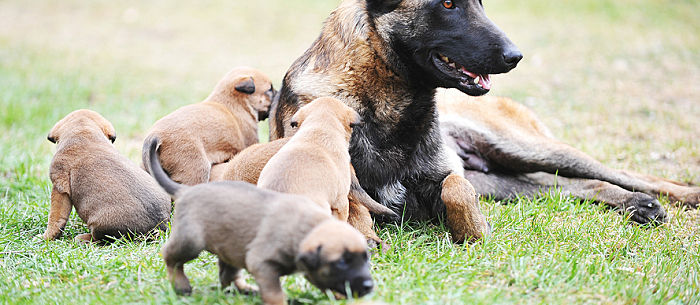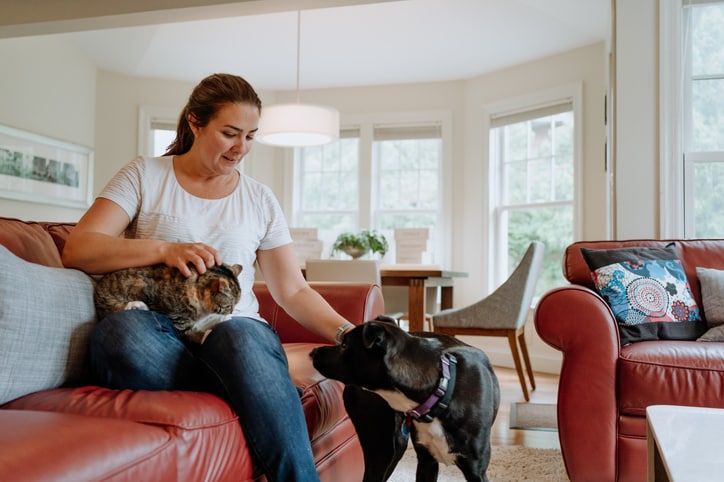Your puppy is constantly asking for food, but you’re worried he might be eating too much. A puppy feeding schedule can help to instill consistent eating habits. If you have a tiny pup with a large appetite, here are some ways to establish a feeding routine.
What Is an Ideal Feeding Schedule for My Puppy?
According to Dr. Randy Aronson, a veterinarian and owner of PAWS Veterinary Center in Tucson, Arizona, an ideal puppy feeding schedule is based on regular feedings spaced throughout the day. Puppies less than four months old should have three feedings — once in the morning, once in the afternoon and once in the evening. As puppies get to four to six months, offer two meals per day — once in the morning and once in the evening. Never give less than two feedings a day, he advises.
Can My Puppy Play After She Eats?
It is very important to “let sleeping dogs lie” after a feeding. According to Dr. Aronson, giving a puppy some down time after a feeding helps to eliminate digestive disturbances, such as gastric bloat or torsion. If your puppy is energetic after feedings, keep the house as calm as possible. Tell the kids your puppy needs a half hour “nap time.” Place your puppy’s bed at the foot of the couch. Dim the lights and enjoy some family quiet time between feedings.

How Can I Establish a Regular Feeding Routine?
Consistency is the key to a routine puppy feeding schedule. Feed your puppy when you eat breakfast, lunch or dinner so you won’t forget to feed him. If you are leaving for the day, do not leave a bowl of food. He may eat all the food at once and end up getting sick.
Instead, have a dog sitter come in to feed your puppy at her scheduled time. If your puppy gets off schedule on occasion, don’t worry. Get on track as soon as you can, and your puppy will adjust.
What Are the Benefits of a Feeding Schedule?
A feeding schedule is beneficial to your dog’s health. You won’t have to worry that your puppy is overeating and gaining weight or undereating and not getting enough nutrients. A well-fed puppy is less likely to eat poisonous food off the floor or chew on hazardous household objects. A feeding schedule can also help with house training. Your puppy is more likely to take a potty break after eating a full meal.
What If My Puppy Is Hungry Between Meals?
If your puppy is constantly going near her bowl, it is okay to offer a snack between feedings. “In between feedings I like to offer snacks that will help with self-soothing,” states Dr. Aronson. Hold your puppy off from eating with a Kong toy, he suggests. Place a dollop of almond butter on the outside to keep your puppy satisfied between feedings.
“Vegetables are healthy snacks for puppies,” states Dr. Aronson. Offer a few cooked carrots or finely chopped green beans once a day. Avoid feeding your puppy grapes, raisins, or onions, as they are toxic to dogs. Although your puppy can digest certain table foods, do not feed a puppy from the table, advises Dr. Aronson. It is easy to lose track of how much your puppy is eating if you are hand feeding.
How Much Should I Feed My Puppy Per Meal?
A feeding schedule varies dramatically depending on the brand of dog food and breed of your dog, according to Dr. Aronson. Smaller breeds, such as papillons, may need to be fed more due to their tendency to have low blood sugar.
Larger breeds, such as Labrador retrievers, may need to eat less due to obesity. The best way to avoid overeating is to allow your puppy to eat for a five- to 10-minute period and then pick up the food. Also, how much you feed your dog really depends on the type and brand of food. If you want to measure food, here are some approximate portions Dr. Aronson suggests.
If you’re feeding your puppy a veggie-rich natural kibble:
If your puppy weighs…then she should get… (total cups, based on three servings per day)
- 3 to 12 lbs. should get 2/3 to 2 cups
- 13 to 25 lbs. should get 1-1/2 to 2-3/4 cups
- 26 to 50 lbs. should get 2-3/4 to 4-3/4 cups
- 51 to 100 lbs. should get 4-3/4 to 7 cups
If you’re feeding your puppy a densely meat-based dry kibble:
If your puppy weighs…then she should get… (total cups, based on three servings per day)
- 3 to 12 lbs. should get 1/2 to 1 cup
- 13 to 25 lbs. should get 1 to 1-3/4 cups
- 26 to 50 lbs. should get 1-3/4 to 2-1/2 cups
- 51 to 100 lbs. should get 2-1/2 to 4 cups
Talk to your vet about how much to feed your puppy of the specific brand and type of food you’ve chosen.
For more information about puppy care, check out Puppy Care Stages: Newborn to 48 Weeks.
Jennifer Gilbert is a freelance pet writer, mother of two beautiful children and owner of a sweet papillon named Kallie. In her spare time she enjoys reading, cooking, traveling and spending time with her family.



